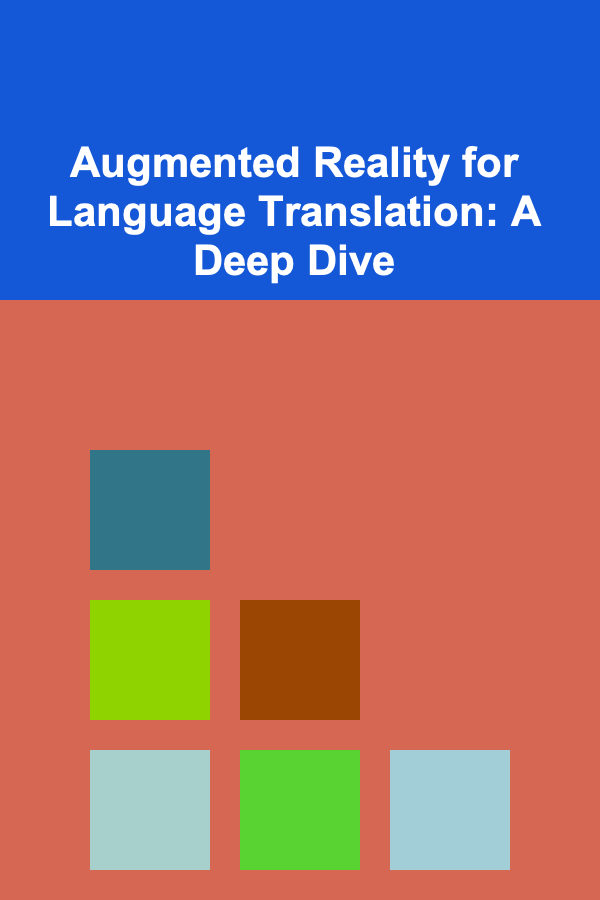
Augmented Reality for Language Translation: A Deep Dive
ebook include PDF & Audio bundle (Micro Guide)
$12.99$6.99
Limited Time Offer! Order within the next:

Introduction: Bridging the Language Gap with Augmented Reality
In an increasingly interconnected world, effective communication is paramount. Language barriers, however, continue to pose a significant challenge to global interactions, hindering travel, business, education, and cultural exchange. Augmented Reality (AR), a technology that overlays computer-generated imagery onto the real world, is rapidly emerging as a powerful tool to address this challenge. AR-powered language translation offers the potential to seamlessly bridge communication gaps, providing users with real-time, contextualized translations that enhance understanding and facilitate more meaningful interactions.
This article delves into the application of AR in language translation, exploring its functionalities, underlying technologies, potential benefits, current limitations, and future directions. We will examine how AR can transform the way we learn and interact with languages, breaking down barriers and fostering a more inclusive and globally connected society.
How AR Translation Works: Unveiling the Core Technologies
AR translation systems leverage a combination of sophisticated technologies to deliver real-time language assistance. Understanding these core components is crucial to appreciating the capabilities and limitations of current AR translation solutions:
- Computer Vision: This is the foundation upon which AR translation is built. Computer vision algorithms analyze the visual input from the device's camera to identify objects, text, and other relevant features within the user's field of view. Object recognition enables the system to understand what it's "seeing," allowing for contextualized translations. Optical Character Recognition (OCR) is a specific computer vision technique used to extract text from images, enabling the translation of printed materials like menus, signs, and documents.
- Natural Language Processing (NLP): NLP is responsible for understanding and processing human language. It analyzes the extracted text to determine its meaning, context, and intent. NLP engines power the translation process, converting the source language into the target language. This includes techniques like machine translation, sentiment analysis (understanding the emotional tone), and named entity recognition (identifying specific people, places, or organizations).
- Machine Translation (MT): MT is the automated translation of text from one language to another. Modern AR translation relies heavily on Neural Machine Translation (NMT), which utilizes deep learning models to achieve significantly higher accuracy and fluency compared to older statistical methods. NMT models are trained on massive datasets of parallel texts (texts translated between different languages), allowing them to learn complex linguistic patterns and generate more natural-sounding translations.
- Augmented Reality Rendering: This component seamlessly integrates the translated text into the user's view of the real world. The translated text can be overlaid directly onto the original text, displayed in a separate window, or presented as audio output. Advanced AR rendering techniques can even adjust the translation's appearance (size, font, color) to match the style of the original text, creating a more visually cohesive experience.
- Real-Time Processing: The entire process -- from image capture to translation rendering -- must occur in real-time to provide a seamless and intuitive user experience. This requires significant computational power and efficient algorithms to minimize latency. Cloud-based processing can offload some of the computational burden from the user's device, but this introduces a dependency on network connectivity.
- Device and Sensors: Smartphones and AR glasses are the primary hardware platforms for AR translation. These devices are equipped with cameras, accelerometers, gyroscopes, and GPS sensors, which provide information about the user's environment and orientation. This data is used to accurately position and anchor the translated text within the augmented reality environment. More advanced AR glasses may also include depth sensors (e.g., LiDAR) to create a more detailed understanding of the user's surroundings, leading to more accurate and stable AR overlays.
The seamless integration of these technologies is critical for creating a compelling and effective AR translation experience. Latency, accuracy, and contextual awareness are key factors that determine the usability and perceived value of these systems.
Applications of AR Language Translation: A Diverse Spectrum
The potential applications of AR language translation are vast and span across numerous sectors:
- Travel and Tourism: Imagine visiting a foreign country and being able to instantly understand street signs, menus, and historical markers simply by pointing your smartphone at them. AR translation can empower travelers to explore new cultures with greater confidence and ease, eliminating the frustration and anxiety associated with language barriers. It can translate spoken conversations in real-time, allowing tourists to engage with locals and navigate unfamiliar environments.
- Education and Language Learning: AR can revolutionize language learning by providing interactive and immersive learning experiences. Students can use AR apps to translate textbooks, practice pronunciation, and learn vocabulary in context. AR can also create virtual language exchange partners, allowing students to practice conversational skills with AI-powered avatars or remote users. Imagine learning a new language by interacting with AR objects that are labeled in the target language.
- Business and International Collaboration: AR can facilitate more effective communication in international business meetings and collaborations. Real-time translation of documents, presentations, and conversations can eliminate misunderstandings and promote smoother workflows. AR can also be used to train employees on operating machinery or following safety procedures in different languages, reducing the risk of accidents and improving overall efficiency.
- Healthcare and Accessibility: AR can break down communication barriers between healthcare providers and patients who speak different languages. Real-time translation of medical instructions, diagnoses, and treatment plans can improve patient outcomes and reduce medical errors. AR can also assist individuals with hearing impairments by providing real-time captions of spoken conversations overlaid onto their field of view.
- Manufacturing and Industry: In globalized manufacturing environments, AR can be used to translate technical manuals, assembly instructions, and safety guidelines for workers from different linguistic backgrounds. This can improve productivity, reduce errors, and enhance workplace safety. AR can also provide real-time translation of spoken instructions during training sessions or on the factory floor.
- Retail and Customer Service: AR can enhance the shopping experience for international customers by providing real-time translations of product labels, descriptions, and customer service interactions. This can increase customer satisfaction and drive sales. AR can also be used to personalize the shopping experience by tailoring content and promotions to the customer's preferred language.
- Emergency Response and Disaster Relief: In emergency situations, effective communication is critical. AR can be used to translate emergency instructions, warnings, and evacuation plans for people who may not understand the local language. This can save lives and improve the effectiveness of disaster relief efforts.
These are just a few examples of the diverse applications of AR language translation. As the technology continues to evolve, we can expect to see even more innovative and impactful uses emerge across various industries and sectors.
Benefits of Using AR for Language Translation: A Transformative Approach
Compared to traditional methods of language translation, AR offers several significant advantages:
- Real-Time and Immediate: AR translation provides instant access to translated information, eliminating the need for manual lookups or delayed interpretations. This immediacy is particularly valuable in situations where quick understanding is crucial.
- Contextual Awareness: AR translation leverages computer vision and NLP to understand the context of the surrounding environment, providing more accurate and relevant translations. This is a significant improvement over simple word-for-word translations, which can often be misleading or nonsensical. For instance, understanding a phrase on a menu requires knowing it's a food item.
- Visual and Intuitive: By overlaying translated text directly onto the real world, AR translation creates a more visual and intuitive learning experience. This can be particularly helpful for visual learners and individuals with cognitive disabilities.
- Hands-Free and Convenient: AR glasses allow users to access translated information without having to hold a device or manually input text. This hands-free approach is particularly useful in situations where users need to keep their hands free for other tasks.
- Accessibility and Inclusivity: AR translation can make information more accessible to individuals who do not speak the local language, promoting greater inclusivity and participation in society.
- Enhanced Learning Experience: By integrating visual and interactive elements, AR translation can make language learning more engaging and effective.
- Breaking Down Cultural Barriers: By facilitating communication and understanding between people from different cultures, AR translation can help to break down cultural barriers and foster greater global collaboration.
- Improved Accuracy over Traditional Methods: While still not perfect, modern NMT-powered AR translation often surpasses the accuracy of older translation methods and can provide more nuance and context.
These benefits highlight the transformative potential of AR language translation to improve communication, enhance learning, and promote greater understanding across cultures.
Challenges and Limitations: Navigating the Current Landscape
Despite its immense potential, AR language translation still faces several challenges and limitations:
- Accuracy of Translation: While machine translation has made significant strides in recent years, it is still not perfect. Errors in translation can occur, particularly with complex sentences, idiomatic expressions, or specialized vocabulary. The accuracy also depends on the language pair and the quality of the training data used to develop the MT model. Sarcasm, humor and other complex linguistic elements still pose significant challenges.
- Computational Power and Battery Life: Real-time AR translation requires significant computational power, which can drain battery life on mobile devices and AR glasses. Efficient algorithms and hardware optimization are crucial for addressing this challenge. Edge computing and optimized hardware are constantly improving this issue.
- Network Connectivity: Many AR translation systems rely on cloud-based services for translation, requiring a stable internet connection. This can be a limitation in areas with poor or no internet access. Offline translation capabilities are becoming increasingly important.
- Privacy Concerns: AR translation systems may collect and store user data, raising privacy concerns. It is important for developers to be transparent about their data collection practices and to implement robust security measures to protect user privacy. Data minimization and anonymization techniques should be employed.
- Hardware Limitations: The current generation of AR glasses is still relatively bulky and expensive, limiting their widespread adoption. Improvements in hardware design and affordability are needed to make AR translation more accessible to the general public. The field of view of current AR glasses can also be limiting.
- Occlusion and Stability: Accurately overlaying translated text onto the real world can be challenging, especially in dynamic environments with complex lighting conditions or frequent occlusions. The stability of the AR overlay is also critical for a comfortable user experience.
- Font Recognition and Text Extraction: OCR performance can vary depending on the font, size, and quality of the original text. Handwritten text and stylized fonts can be particularly challenging to recognize. The angle and lighting can drastically affect the OCR results.
- Contextual Ambiguity: Even with advanced NLP techniques, resolving contextual ambiguity can be difficult. A single word or phrase can have multiple meanings depending on the context, leading to inaccurate translations.
- Cultural Sensitivity: Translations should be culturally sensitive and avoid offensive or inappropriate language. This requires a deep understanding of cultural nuances and the potential for misinterpretations.
Addressing these challenges is crucial for unlocking the full potential of AR language translation and ensuring its widespread adoption and acceptance.
Future Directions: Innovations and Emerging Trends
The field of AR language translation is rapidly evolving, with several exciting innovations and emerging trends shaping its future:
- Improved Accuracy and Fluency: Ongoing research and development in machine translation are leading to more accurate and fluent translations. Advancements in neural network architectures, training data, and context modeling are constantly improving the quality of translations.
- Edge Computing and Offline Translation: Moving more of the computational burden to the edge (e.g., on the device itself) reduces the reliance on cloud-based services and enables offline translation capabilities. This is particularly important for users in areas with limited or no internet connectivity.
- Personalized Translation: Future AR translation systems will be able to personalize translations based on the user's language proficiency, learning style, and cultural background. This will create a more tailored and effective learning experience.
- Integration with AI Assistants: Integrating AR translation with AI assistants like Siri and Google Assistant will enable users to access language assistance through voice commands and natural language interactions.
- Improved Hardware and Ergonomics: Advances in display technology, miniaturization, and battery technology will lead to lighter, more comfortable, and more affordable AR glasses. These improvements will make AR translation more accessible and practical for everyday use. Contact lens AR might even become a reality.
- Multimodal Translation: Future AR translation systems will be able to translate not only text but also speech, gestures, and other forms of communication. This will create a more comprehensive and immersive translation experience. Translating sign language is an especially important area of development.
- AI-Powered Error Correction: AR translation systems will be able to automatically detect and correct errors in translation, improving the overall accuracy and reliability of the system.
- Real-time Collaboration: AR systems will enable real-time collaborative translation, where multiple users can work together to translate documents, conversations, or other content.
- Domain-Specific Translation: Training translation models on domain-specific data (e.g., medical texts, legal documents) will improve the accuracy and fluency of translations in specialized fields.
These future directions promise to further enhance the capabilities of AR language translation, making it an even more powerful and versatile tool for communication, learning, and cultural exchange.
Ethical Considerations: Responsible Development and Deployment
As with any powerful technology, it is essential to consider the ethical implications of AR language translation:
- Bias in Translation: Machine translation models can inherit biases from the data they are trained on, leading to biased or discriminatory translations. Developers must be aware of these biases and take steps to mitigate them. Careful dataset curation and bias detection algorithms are crucial.
- Privacy and Data Security: Protecting user privacy and ensuring data security are paramount. Developers must be transparent about their data collection practices and implement robust security measures to prevent unauthorized access or misuse of user data.
- Job Displacement: The widespread adoption of AR language translation could potentially lead to job displacement for human translators. It is important to consider the social and economic implications of this technology and to provide support for displaced workers. Retraining and upskilling initiatives can help translators adapt to the changing job market.
- Misinformation and Manipulation: AR translation could be used to spread misinformation or manipulate users by providing inaccurate or misleading translations. Developers must take steps to prevent the misuse of this technology. Watermarking and authentication techniques can help to identify and prevent the spread of fake translations.
- Over-Reliance on Technology: It is important to avoid over-reliance on AR translation, as this could lead to a decline in language learning and cultural understanding. AR translation should be used as a tool to augment, rather than replace, human communication.
- Accessibility and Equity: AR translation should be accessible to all, regardless of their socioeconomic status or technological literacy. Developers should strive to create affordable and user-friendly systems that can be used by a wide range of users.
By addressing these ethical considerations, we can ensure that AR language translation is developed and deployed in a responsible and beneficial manner.
Conclusion: A Future Shaped by Seamless Communication
Augmented Reality language translation holds immense promise for transforming the way we communicate, learn, and interact with the world. By seamlessly overlaying translated text and audio onto the real world, AR can break down language barriers, foster greater understanding, and create a more inclusive and globally connected society.
While challenges and limitations remain, ongoing advancements in computer vision, natural language processing, and AR hardware are paving the way for more accurate, reliable, and user-friendly translation systems. As the technology continues to evolve, we can expect to see AR language translation become an increasingly integral part of our daily lives, shaping a future where communication is seamless, accessible, and truly global.
The convergence of these technologies paints a picture of a future where understanding transcends linguistic divides, opening doors to new opportunities for collaboration, learning, and cultural exchange on a global scale. The journey is ongoing, but the potential impact of AR language translation is undeniable.
Reading More From Our Other Websites
- [Home Cleaning 101] How to Freshen Up Your Bathroom with Simple Cleaning Hacks
- [Star Gazing Tip 101] How to Plan a Multi‑Night Star‑Gazing Expedition Aligned With the Perseid Meteor Shower
- [Personal Finance Management 101] How to Manage Multiple Debts and Pay Them Off Faster Using the Avalanche Method
- [Organization Tip 101] How to Organize Your Bathroom Countertops for a Spa-Like Feel
- [Organization Tip 101] Why Using Color Coding Makes Organization Fun
- [Home Party Planning 101] How to Incorporate Interactive Elements into Your Home Party
- [Home Lighting 101] How to Use Wall Sconces for Elegant and Practical Lighting
- [Home Pet Care 101] How to Keep Your Pet's Health in Check with Regular Home Care
- [Personal Care Tips 101] How to Give Yourself a Relaxing Facial with a Gua Sha Tutorial
- [Home Security 101] How to Install Smart Locks for Home Security and Convenience

How to Create a Checklist for Reviewing and Updating Company Policies After Offboarding
Read More
How to Sell Digital Products Successfully for First-Time Entrepreneurs
Read More
How To Understand the Power of Delayed Gratification
Read More
How to Find Your Unique Writing Voice
Read More
How to Exercise at Home for Weight Loss
Read More
How to Identify Constellations Using a Star Chart
Read MoreOther Products

How to Create a Checklist for Reviewing and Updating Company Policies After Offboarding
Read More
How to Sell Digital Products Successfully for First-Time Entrepreneurs
Read More
How To Understand the Power of Delayed Gratification
Read More
How to Find Your Unique Writing Voice
Read More
How to Exercise at Home for Weight Loss
Read More